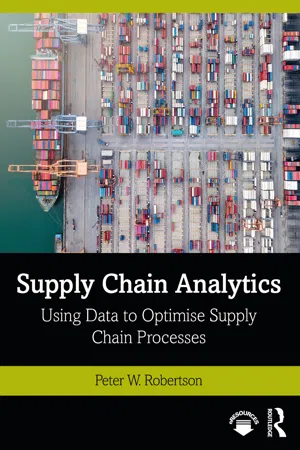
Supply Chain Analytics
Using Data to Optimise Supply Chain Processes
- 298 pages
- English
- PDF
- Available on iOS & Android
About this book
Supply Chain Analytics introduces the reader to data analytics and demonstrates the value of their effective use in supply chain management. By describing the key supply chain processes through worked examples, and the descriptive, predictive and prescriptive analytic methods that can be applied to bring about improvements to those processes, the book presents a more comprehensive learning experience for the reader than has been offered previously.
Key topics are addressed, including optimisation, big data, data mining and cloud computing. The author identifies four core supply chain processes – strategy, design, execution and people – to which the analytic techniques explained can be applied to ensure continuous improvement. Pedagogy to aid learning is incorporated throughout, including an opening section for each chapter explaining the learnings designed for the chapter; worked examples illustrating how each analytic technique works, how it is applied and what to be careful of; tables, diagrams and equations to help 'visualise' the concepts and methods covered; chapter case studies; and end-of-chapter review questions and assignment tasks.
Providing both management expertise and technical skills, which are essential to decision-makers in the supply chain, this textbook should be essential reading for advanced undergraduate and postgraduate students of supply chain analytics, supply chain leadership, and supply chain and operations management. Its practice-based and applied approach also makes it valuable for operating supply chain practitioners and those studying for professional qualifications.
Online resources include chapter-by-chapter PowerPoint slides, tutorial exercises, written assignments and a test bank of exam questions.
Frequently asked questions
- Essential is ideal for learners and professionals who enjoy exploring a wide range of subjects. Access the Essential Library with 800,000+ trusted titles and best-sellers across business, personal growth, and the humanities. Includes unlimited reading time and Standard Read Aloud voice.
- Complete: Perfect for advanced learners and researchers needing full, unrestricted access. Unlock 1.4M+ books across hundreds of subjects, including academic and specialized titles. The Complete Plan also includes advanced features like Premium Read Aloud and Research Assistant.
Please note we cannot support devices running on iOS 13 and Android 7 or earlier. Learn more about using the app.
Information

Table of contents
- Cover
- Half Title
- Title
- Copyright
- Dedication
- Contents
- Examples included in this book by analytic technique
- Examples included in this book by supply chain process
- About the author
- Foreword
- Preface
- Acknowledgments
- 1 Introduction to supply chain analytics
- 2 Supply chain analytics in practice
- 3 Getting started with supply chain analytics
- 4 Using supply chain analytics to enhance supply chain strategy processes
- 5 Using supply chain analytics to enhance supply chain design processes
- 6 Using supply chain analytics to enhance supply chain execution processes
- 7 Using supply chain analytics to enhance supply chain people processes
- 8 How to deal effectively with organisational social issues
- Appendix
- Index